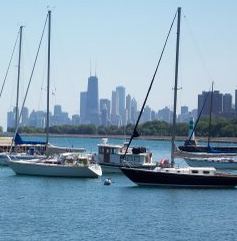 Chicago became another in a long list of U.S. cities taking the lead in the fight against climate change.
Chicago became another in a long list of U.S. cities taking the lead in the fight against climate change.
On Thursday, Chicago mayor Richard M. Daley unveiled a plan to reduce greenhouse gas emissions to 25 percent below 1990 levels by 2020 — and continue to cut even faster beyond that.
“I believe that when you do such things as planting trees and creating open space, when you invest resources to remove pollution from the air and encourage the construction of buildings that are smart for the environment, then you enhance quality of life for all the residents of the city.”
But, this is about more than cleaning up our environment, the Mayor said. “At the same time, when we make these improvements we’re greening our economy for the future and creating the jobs of tomorrow,” Daley said.
The detailed Chicago Climate Action Plan outlines 29 actions that can be taken for mitigating greenhouse gas in four areas: buildings; transportation; energy; and waste pollution.
Other cities have set similar goals, but Chicago’s plan is the first to both identify emission sources and anticipated impacts, and propose ideas that specifically respond to that research.
Three Ideas in the Plan that Chicago will Implement Right Away:
- A “Green Office Challenge” that will spur high rise office buildings to save energy, increase recycling and water efficiency and reduce paper.
- An updated Chicago Energy Efficiency Building Code, which will bring our current code up to international standards and be easier to understand.
- Innovative ways to help property owners save money by making their buildings more energy efficient.
Steps Being Considered:
- Large scale solar energy installations at City facilities.
- New partnerships to make it easier for residents and businesses to take greater advantage of public transportation and save money.
- The construction of four publicly accessible alternative fueling stations.
- Implementation of key components of the Chicago 2015 Bike Plan.
- A communications and outreach plan to engage all residents and businesses in the Chicago Climate Action Plan.
“Thankfully, during this tough economy there is some funding already committed from private resources to help pay for parts of this plan, but not nearly enough.” Daley said. “Over the next few years we’ll be depending on the commitment of individuals, businesses and others to do their part. And, of course, it will very important for Springfield and the federal government in Washington, D.C. to do their part and provide greater resources for public transportation, building improvements, research on new technologies and other measures,” he said.
Steps for Chicago Individuals to Take:
- Driving less and walking more
- Using more energy-efficient light bulbs
- Turning down the thermostat a few degrees in winter or up a few degrees in summer.
- Insulating and weatherizing your home.
- Turning off appliances and computers when they’re not in use, and
- Planting trees and shrubs around your home to reduce temperatures.
Chicago has already been a leader in innovative initiatives in their goal to become “the most environmentally friendly city in the nation”, like, planting more than a half million trees, mandating the construction of environmentally friendly buildings and installing roof top gardens on city owned buildings.
Chicago also boasts more Leadership in Energy and Environmental Design-certified (LEED) buildings than any other city and has more than four million square feet of green roof projects either completed or underway. Over the past two years alone, the city has helped to distribute more than one million energy-saving compact fluorescent light bulbs to residents and passed a comprehensive storm water management ordinance.
The City launched a Climate Action Web site at www.chicagoclimateaction.org where individuals and businesses can learn about climate change, what they can do in their daily lives to reduce emissions, and what the City is doing to protect and preserve the environment.
“In Chicago we have long appreciated that cities are no longer the enemies of the natural environment; rather they’re leading the way in preserving and protecting it,” Daley said.



















